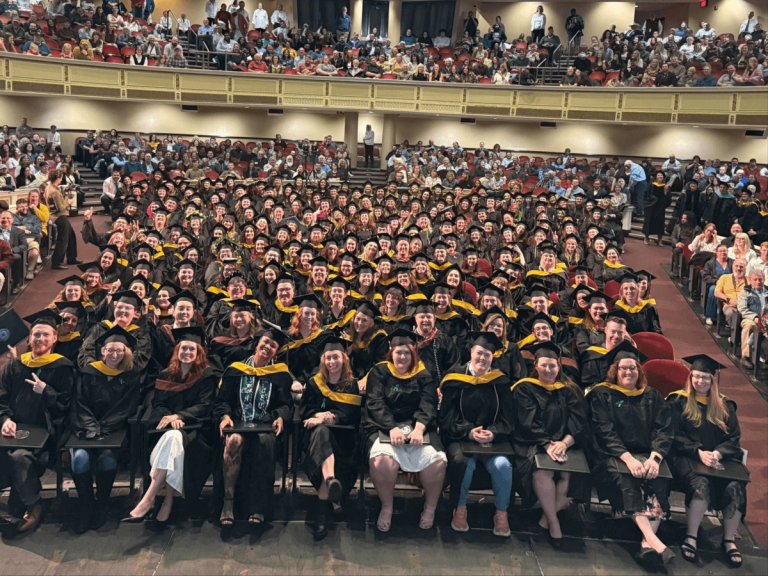Unity College weaves sustainability into every aspect of the curriculum, from science courses to field work to art classes. It is a cross-disciplinary approach across all of the College’s majors and programs, and is maintained by all faculty.
Professor of Art Ben Potter gives students first hand examples of how an artist can use the backdrop of sustainability when creating works of art. Often, his classes are taught with the sensibility that he brings to his own art, and use repurposed materials to create inspirational works. These pieces can serve as a bridge from the “what once was” to the present and offer sustainability as a point of view.
Potter says that at Unity College, the art classes require students to observe and create in a manner that may be unfamiliar to them. There are no hard and fast rules, no data sets or protocols. Potter says that this can be puzzling to some.
For example, in his Art Explorations course entitled “Re-Use”, Potter asks students “How can art communicate and illuminate aspects of sustainability?” and “What are the connotations and possibilities of non-traditional art materials?” During the course, Potter takes his class through the process of using found and recycled material to make 2 and 3-dimensional art. He engages Unity students in problem-based assignments that combine craftsmanship and basic formal principles of art with trans-disciplinary concepts.
In his own work, Potter finds interest in taking everyday materials and reworking them to give the viewer a new definition, a new point of view. He offers that one can imagine how sustainability and art can be intertwined by thinking about the relationship between the concrete and the mysterious and more specifically, how the two can be synthesized. This dynamic is what gives art its power, and also speaks to the work of sustainability.
Sustainability by definition connotes an extended effort, a prolonged way of working and being, and staying steady, with sustenance a running theme.
Potter ascribes to the theory that the liberal arts model of education guides students to expand their intellectual watershed, and art helps to expand and interpret these territories.
“What sustains us?” Potter asks. “Not just food, shelter and breathable air. Friends, music, literature, and art: these things give our lives a resonance and intricacy. I often wonder, how will students live the rest of their lives?”
Recently, Potter has exhibited his own sustainably-referenced art with two shows in Portland, Maine. In addition, his work is now included in the flat file program at the Pierogi Gallery in Brooklyn, New York (click here to view Potter’s work).
His exhibit, “Bent Space” at THINK TANK is a collection of works on paper, panel and canvas that distill and elaborate upon patterns found in the landscape. At the Coleman Burke Gallery, Potter’s work entitled “Heavy” is a series of plywood sculptures that are stacked, suspended and leaning to create the measure of the title of his installation. His cut form investigations of landscapes have elevated the notion of what viewers have come to expect from the classic term “landscape” in visual art.
In addition to these accomplishments, Potter was included in the latest Center for Maine Contemporary Art Biennial and was recently awarded a Good Idea Grant from the Maine Arts Commission.
Potter feels that making art employs an agility and subtlety of mind and heart. It links the concrete and the ineffable. The effect of a work of art on the viewer can range from a glancing blow to deep and abiding resonance, and both effects are worthy.
“I try to ground our work in the notion that art is a discipline of attention, of observing the world closely and making some sense of what we see, much like biologists or hunters or bird watchers,” said Potter. “I also stress that it involves work and patience. Time spent experimenting and constructing pieces is absolutely necessary, and in the best cases, craftsmanship goes hand in hand with conceptual vigor.”
Unity College Board member Linda Povey is a marketing professional, and, among many other things, an artist, and maintains a blog so that she can share perspectives on the creative process. A recent posting recognizes the importance of art in widening the dialog about sustainability.
She feels that Unity students are fortunate that the art professors like Potter stay true to the notion of cross-disciplinary sustainability, and says that to experience this wider perspective, students learn not only the science of sustainability, but also how to express it through art and communication.
“Although Unity’s focus is science-based, the College differentiates itself by recognizing that the future of sustainability depends on a clearer understanding of the dimensionality of sustainability and the broader world view each one of us must embrace,” said Povey.
Povey feels that professors like Potter provide an important dimensional perspective on sustainability.
“Through this diverse, liberal arts education, the Unity graduates seemed prepared to not only find tangible solutions to the environmental challenges we face, but to change the way society sees and thinks about environmental issues,” continues Povey. “And isn’t that the greatest challenge of all?”
In recent years Unity College has gained national attention for a variety of achievements including: its focus on sustainability science, the leading-edge of 21st century ecological problem solving and the vanguard in the fight for the mitigation of global climate change; its ground-breaking “green” innovations such as the award-winning TerraHaus, the first student residence on a college or university campus built to the Passive House standard, the most energy efficient building standard in the world; and for being the first college in the United States to divest from investments in fossil fuels, igniting a growing national movement in higher education.
Unity College is a private college in rural Maine that provides dedicated, engaged students with a liberal arts education that emphasizes the environment and natural resources. Unity College graduates are prepared to be environmental stewards, effective leaders, and responsible citizens through active learning experiences within a supportive community.
(Photo courtesy of the Coleman Burke Gallery)



